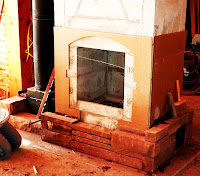Now, whenever I see construction workers, bulky in their multi-layer garb, welding the framework of a three-story office building or moving pre-fab walls into place, and doing all of this in the grasp of winter’s icy hand, I remember watching my dad do the very same thing. I’m sure they, like my dad, are happy when the walls of a project are finally up and the grip of snow and wind clutches air and brick instead of cloth and skin.
When we asked our neighbor and mason friend, Wade Hansen, if he might be interested in creating the facade for our masonry heater, I completely understood the smile that appeared on his face as he contemplated the possibly of indoor work (complete with heat, light and plumbing) in December. His bid was one we decided we had to afford because Wade’s work is so beautiful. Here are photos of his progress thus far. We are lucky to have such a fine craftsman working with us.

































